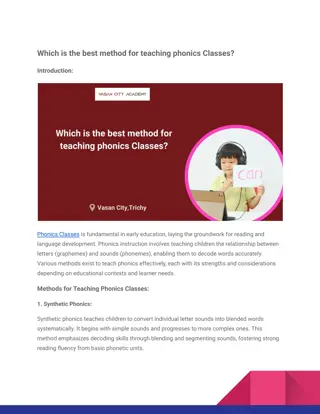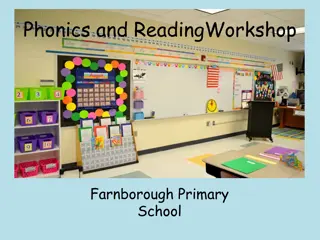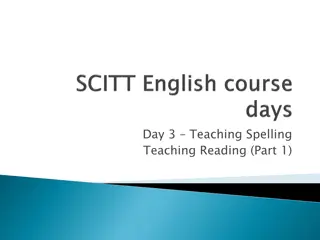Effective Phonics Teaching Strategies for Year One Children
Explore the structured phonics teaching programme aiming to meet Year One standards, emphasizing the importance of phonics for reading and writing skills development. Engage with daily interactive activities, games, and partner work sessions for 20 minutes each day. Learn key definitions such as grapheme and phoneme, practice blending words from phonemes, recognize common exception words, and access helpful resources like Twinkl Phonics and Phonics Play website. Stay involved in your child's reading journey, and support them through reading every night. For children who need extra help, repeat phonics teaching in Year 2 is available.
Download Presentation

Please find below an Image/Link to download the presentation.
The content on the website is provided AS IS for your information and personal use only. It may not be sold, licensed, or shared on other websites without obtaining consent from the author. Download presentation by click this link. If you encounter any issues during the download, it is possible that the publisher has removed the file from their server.
E N D
Presentation Transcript
PHONICS PRESENTATION Thank you for coming
Programme Overview Teaching of phonics follows a structured route for most children to meet or exceed the expected standard in the Year One Phonics Screening Check Lime: Levels 1-4 Larch: Level 5
The Importance Of Phonics Learning phonics will help your child to become a good reader and writer. Children need to be able to hear the separate sounds in a word and then blend them together to say the whole word.
Daily for 20 minutes Interactive PPT activities Games to play Partner work Fun, interactive, fast
Key Definitions Grapheme: letter or letters that represent a sound, for example - a, sh, igh, ou Phoneme: unit of sound
Key Definitions Digraph: 2 letters that make one sound. For example- ee, th, au Split digraph: magic e . For example- i-e, o-e, a-e, u-e, e-e pie pine toe tone
Blending Hands Building words from phonemes to read. c a t cat
today be Common Exception words pull the Words that don t follow the phonics rule. I she my mind
Resources We follow Twinkl phonics: a structured programme that engages and challenges children. Phonics Play website has some free resources and games
For those children that dont pass they will repeat the year s phonics teaching in Year 2.
Helpful tips! Try and read every night with your child. If they are reluctant share the book, look at the pictures and discuss the story. If your child is struggling: before they start to read discuss the pictures, highlighting different characters and objects you can see where the word appears in the text. Together think about the phonemes (sounds) in that word and find the word in the text. Encourage children to break down words and use their blending hands. Reread pages together. Make it fun!
Make it fun! Little and often. Lime: 1 or 2 pages every night, Larch 2- 4 pages every night. Role model enjoyment of books, have some family reading time. Discuss likes and dislikes, character, plot and any interesting words the author has used. Developing a love of Developing a love of reading reading Reading is not about just reading the words! Read a story to your child and discuss it, enjoy making predictions together. Build up fluency by asking the child to reread some pages. Adults reread some modelling good expression. When children struggle with a tricky word use clues: pictures, the rest of the sentence. Share a range of books, please don t just read the school book!
Million word gap Reading a book to your child (not a school reading book) every day makes an enormous difference to your child s language and reading skills. One short book a day a 4 year old child will hear almost 300,000 more words than those whose parents didn t read to them at all. Five books per day increases their vocabulary by 1.4 million words!























